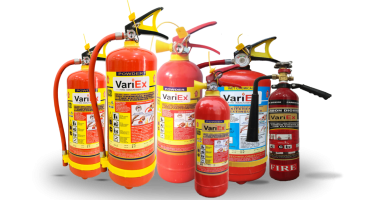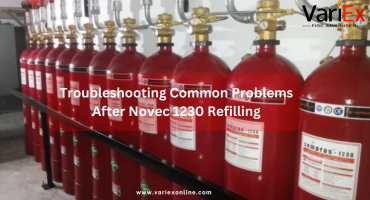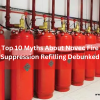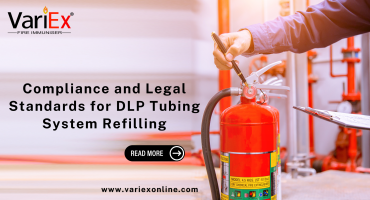![]()
Fire Immuniser
+91-7829629111
Email: info@variex.in
Varistor Technologies Pvt. Ltd.
Block-1, First Floor, Ardente Office One, Hoodi Circle, ITPL Main Road, Bengaluru, Karnataka 560048, IN
Fire Suppression Refill Schedules
Fire Suppression Refill Schedules
In fire safety, reliability is everything. A fire suppression system might be your first and only line of defense in the event of a fire. However, like any life-saving equipment, it must be regularly maintained to ensure optimal functionality. One of the most critical aspects of maintenance is adhering to an appropriate fire suppression refill schedule.
Delaying refills or skipping inspections can result in system failure, increased fire risk, and legal or financial consequences. Understanding how often to refill your specific system can make the difference between disaster prevention and damage control.
Understanding Fire Suppression Systems and Their Refill Cycles
Fire suppression systems automatically detect and suppress fires using extinguishing agents such as carbon dioxide (CO₂), FM-200, dry chemicals, or wet chemicals. These agents are stored under pressure in tanks or cylinders. If discharged—or even slightly depleted—the system must be refilled immediately to maintain protection.
There’s no one-size-fits-all schedule. Different systems have different refill needs based on factors like system type, environment, usage, and local regulations.
Types of Fire Suppression Systems and Typical Refill Requirements
Here’s a quick breakdown of common system types and when they typically need refilling:
CO₂ Systems: Often require semi-annual inspections and are refilled as needed, usually after any discharge or pressure drop.
FM-200 (Clean Agent Systems): Inspected annually and refilled immediately after discharge or if pressure drops below acceptable levels.
Dry Chemical Systems: Common in industrial applications; need semi-annual inspections and post-activation refills.
Wet Chemical Systems: Designed for kitchens; typically inspected quarterly and refilled annually or after use.
Fire Suppression Refill Schedule Table
| Fire Suppression System | Inspection Frequency | Refill Frequency | Refill Trigger |
|---|---|---|---|
| CO₂ System | Every 6 months | As needed | Pressure drop or after discharge |
| FM-200 | Every 12 months | After discharge | Event-based or inspection findings |
| Dry Chemical | Every 6 months | As needed | Post-activation or during maintenance |
| Wet Chemical | Every 3 months | Every 12 months | Post-discharge or system testing |
| Clean Agent (Inert Gas) | Every 12 months | After discharge | Loss of pressure or detection issues |
Annual Refill Schedules: Suitable for Low-Risk Environments
Annual refills are typical for clean agent systems like FM-200 or inert gas systems in low-risk environments such as office buildings or libraries. These systems rarely discharge unless a fire occurs, making them ideal for a once-a-year maintenance plan. However, this schedule assumes that inspections are happening regularly and pressure levels remain stable.
When Semi-Annual Refills Are Necessary
Semi-annual refills are commonly required in industries with higher fire risks—like manufacturing, automotive, or data centers—especially for CO₂ and dry chemical systems. These systems often work under harsh conditions and are more likely to experience minor leaks or pressure drops. Refilling every six months ensures the system maintains the agent levels necessary to protect expensive assets and lives.
Event-Based Refilling: Immediate Action After Activation
If your system activates—even partially—it requires immediate refilling. Fire suppression systems are designed to be fully charged at all times. Event-based refilling is triggered by:
Full or partial discharge
Noticeable pressure loss
Failed system test
Physical damage to the container or valve
Tamper seal breakage
Ignoring a refill after any of the above events can leave your property vulnerable and may void your insurance coverage.
Role of NFPA Guidelines in Scheduling
The National Fire Protection Association (NFPA) has created standardized codes to guide fire safety practices, including system refilling:
NFPA 12 – Carbon Dioxide Systems
NFPA 17/17A – Dry and Wet Chemical Systems
NFPA 2001 – Clean Agent Systems (FM-200, Inergen, etc.)
These codes specify inspection and maintenance frequencies and provide benchmarks for acceptable pressure loss. Staying compliant with NFPA standards ensures your systems meet both safety and insurance requirements.
Factors That Influence Refill Frequency
Not all refill schedules are dictated by time alone. Several factors impact how often your system should be refilled:
System Type – CO₂ systems tend to leak more often; wet chemical systems are exposed to grease.
Usage Rate – Systems that have been activated even once must be immediately refilled.
Environmental Conditions – High temperatures, humidity, or vibration can accelerate pressure loss.
Regulations – Local fire codes may mandate more frequent refilling than industry standards.
Inspection Reports – If an inspection identifies a problem, a refill is typically part of the correction process.
Smart Monitoring and Automation
Newer systems often include IoT-enabled sensors that automatically monitor pressure, temperature, and other critical data points. These technologies help maintenance teams identify leaks or failures in real-time, making event-based refilling easier and more efficient. Some systems even alert technicians via SMS or app notifications when pressure dips below the safe range.
Risks of Skipping or Delaying Refills
Neglecting proper refill schedules can have serious consequences:
System Failure – The system won’t activate during a fire if the agent is insufficient.
Insurance Loss – Many insurers require documented maintenance. Failure to comply could result in claim denial.
Regulatory Fines – Fire marshals and local inspectors can issue citations for non-compliance.
Increased Liability – If a fire causes injury or damage and the system was not operational, you may be held legally responsible.
How to Choose a Fire Suppression Refill Provider
Choose a licensed and certified provider who:
Offers services that comply with NFPA and OSHA standards
Can provide pressure testing and agent weighing
Maintains maintenance logs and refill certifications
Uses only manufacturer-approved agents
Provides emergency refill services for activated systems
Refilling isn’t just about replacing the agent—it’s about restoring full system functionality. Trust only qualified professionals with this task.
Building a Custom Refill Plan for Your Business
To create an effective fire suppression refill schedule, consider:
The type and number of suppression systems you operate
Building occupancy and fire risk profile
Existing fire protection infrastructure
Local fire codes and insurance policy requirements
Maintenance history and inspection data
Working with a fire safety consultant can help you build a compliant and customized plan to protect your facility long-term.
Conclusion
Proper fire suppression refill scheduling is essential for safety, compliance, and peace of mind. Whether your system requires an annual, semi-annual, or event-based refill, regular inspections and professional refilling services are non-negotiable. Following industry standards, such as those from the NFPA, and monitoring system conditions will ensure your fire suppression system is always ready to perform when needed.
Frequently Asked Questions
Refilling is typically required after any discharge or if inspection reveals low pressure. Most systems are refilled annually or semi-annually based on type and environment.
No. Inspection checks for leaks and functionality. Refilling replaces the extinguishing agent if depleted.
No. Refilling must be performed by a certified technician following NFPA standards and local regulations.
Your system won’t function during the next fire event, and you may be non-compliant with legal or insurance standards.
Yes. Local regulations, standards (like BS EN in the UK or ISO internationally), and climate conditions may influence refill intervals.
Final Say
At VariEx.in and VariexOnline.com, we specialize in supplying and installing top-quality fire fighting systems and equipment. From fire extinguishers to advanced suppression systems, we offer comprehensive solutions tailored to your needs. Our experienced team ensures precise installation and maintenance for optimal safety.
Trust VariEx for reliable fire protection. Contact us online or call 7829629111 to learn more.
We specialize in manufacturing, supplying, and distributing a comprehensive range of fire fighting equipment, including state-of-the-art fire extinguishers. Read our most searched blogs and find interesting information on topics such as how to use a fire extinguisher, how to calculate fire fighting water tank capacity, fire extinguisher refilling, obtaining a Fire NOC, understanding fire fighting systems, types of fire protection systems, the fire hydrant system, and the fire sprinkler system. These resources provide essential knowledge for ensuring safety and compliance with fire safety regulations. Additionally, you can explore guides on the maintenance of fire protection equipment, the latest advancements in fire safety technology, and best practices for fire risk assessment and management.
Our expertise extends to fire alarm systems, fire hydrant systems, and fire suppression systems, including fire sprinklers. Each product meets rigorous international standards for reliability and performance, ensuring effective fire safety products tailored to diverse applications and industries. Additionally, we are providing Fire Extinguisher Refilling and AMC services to ensure ongoing maintenance and operational readiness of fire safety equipment.
"WHAT YOU CAN READ NEXT"
 Read more +24 November 2023 in Fire Extinguisher
Read more +24 November 2023 in Fire ExtinguisherWhat types of fire extinguishers are available for different fire classes?
 Read more +18 April 2025 in Fire Suppression
Read more +18 April 2025 in Fire Suppression





